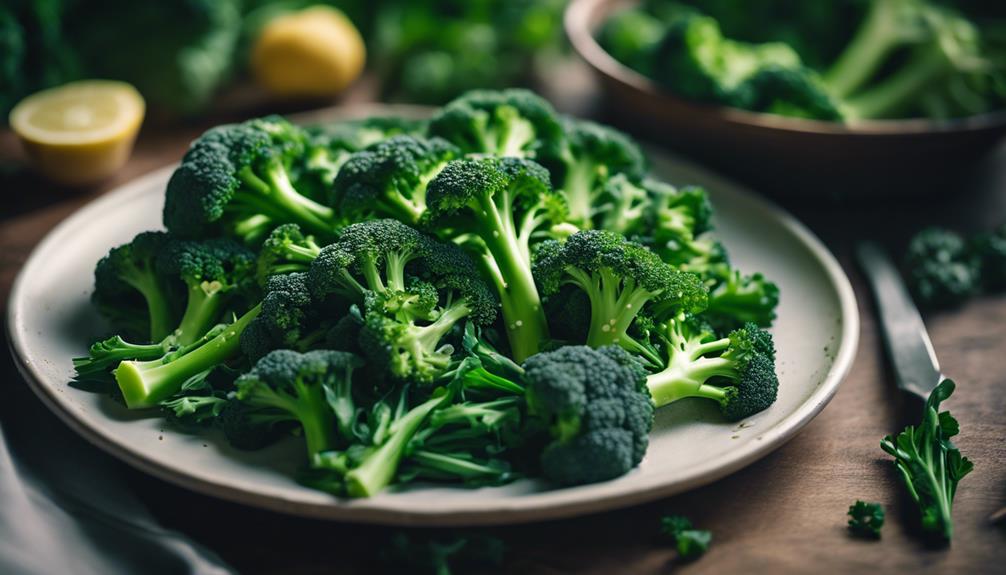Broccoli rabe, rich in vitamins A, C, and K, boosts immune health and aids in blood clotting. With its abundance of antioxidants, it fights inflammation and helps prevent chronic diseases. Enhancing digestion and providing calcium for strong bones, this low-calorie wonder promotes overall well-being. When preparing, blanch to reduce bitterness or sauté with olive oil and garlic for added flavor. Pairing with parmesan or grilling for a smoky touch elevates dishes. Choose fresh bunches, store in a plastic bag in the refrigerator, and enjoy this nutritious gem within 3-4 days for optimal freshness. Explore a new world of flavor and health benefits with broccoli rabe.
Key Takeaways
- Broccoli rabe is rich in essential vitamins and antioxidants for immune health and disease prevention.
- Cooking techniques like blanching and sautéing enhance flavor and texture.
- Pair broccoli rabe with pasta or seafood for a nutritious and flavorful side dish.
- Choose fresh bunches with vibrant green leaves and store properly for lasting freshness.
- Enjoy the unique taste and texture of broccoli rabe to elevate your dining experience.
Health Benefits of Broccoli Rabe
Rich in essential vitamins and antioxidants, broccoli rabe offers a plethora of health benefits that can enhance your overall well-being. This leafy green is packed with vitamins A, C, and K, important for supporting your immune function, maintaining healthy skin, and aiding in proper blood clotting.
The antioxidants found in broccoli rabe play a significant role in reducing inflammation and protecting your body against chronic diseases. Additionally, the fiber content in broccoli rabe promotes good digestion and supports gut health.
With a notable amount of calcium, this vegetable contributes to strong bones and excellent muscle function. In addition, incorporating broccoli rabe into your diet may help lower cholesterol levels and decrease the risk of heart disease.
Nutritional Value of Broccoli Rabe

Moreover, broccoli rabe is packed with essential vitamins like A, C, and K, which contribute to overall health.
It also boasts a high antioxidant content, aiding in the fight against harmful free radicals in the body.
In addition, being low in calories, broccoli rabe is a nutritious addition to your diet that can support your well-being.
Rich in Vitamins
Boasting a powerhouse of essential vitamins, broccoli rabe is a valuable addition to your diet for its nutritional benefits. This leafy green is packed with vitamins A, C, and K, important for maintaining overall health and boosting your immune system.
Additionally, broccoli rabe provides a good dose of antioxidants, fiber, iron, and calcium, essential for a balanced diet. The consumption of this vegetable can aid in supporting bone health, lowering cholesterol levels, reducing the risk of cancer, and preventing heart disease.
Despite its bitter taste, broccoli rabe's flavors can be harmonized with other ingredients, making it a versatile and flavorful component in various dishes. By roasting broccoli rabe, you can tone down its bitterness and reveal a delightful nutty flavor, appealing to a broader range of tastes.
Incorporating this nutrient-rich vegetable into your meals can greatly enhance your overall nutritional intake.
High in Antioxidants
High in antioxidants, broccoli rabe offers a multitude of health benefits that support your overall well-being and vitality. The bitter taste of broccoli rabe signifies its importance in antioxidants, which play a critical role in protecting your cells from damage caused by free radicals. These antioxidants, such as vitamins A, C, and K, not only combat oxidative stress but also bolster your immune system and help reduce inflammation within your body.
Low in Calories
With its low calorie content, broccoli rabe serves as an excellent choice for individuals seeking to maintain a healthy weight and support overall well-being. Incorporating this nutritious and flavorful vegetable into your meals can help you achieve a balanced diet while keeping your calorie intake in check. Here are a few key points to take into account:
- Broccoli rabe is low in calories, with just about 30 calories in a 1-cup serving of cooked broccoli rabe.
- Enjoying broccoli rabe can be guilt-free, allowing you to savor it as a side dish or ingredient in various recipes without worrying about excess calories.
- Including broccoli rabe in your diet regularly can help you feel satisfied while supporting a healthy weight and overall well-being.
Cooking Techniques for Broccoli Rabe

To bring out the best flavors in broccoli rabe, consider blanching for brightness and sautéing for enhanced taste. Blanching helps to soften tough stems quickly, while sautéing with olive oil, garlic, and red pepper flakes adds depth to the dish.
These cooking techniques can elevate the overall flavor profile of broccoli rabe when preparing it as a side dish or pairing it with Italian recipes.
Blanching for Brightness
For a vibrant and less bitter broccoli rabe dish, consider blanching the greens in boiling water before cooking. Blanching broccoli rabe in boiling water helps maintain its bright green color and reduces bitterness. This quick cooking method softens the tough stems of broccoli rabe for a more enjoyable texture.
By blanching broccoli rabe before sautéing or incorporating it into recipes, you can enhance its overall flavor profile. Additionally, blanching broccoli rabe allows you to prepare it for various dishes while preserving its nutritional value. Brightening up broccoli rabe through blanching ensures a vibrant and visually appealing presentation in your recipes.
Sautéing for Flavor
Blanching broccoli rabe sets the stage for enhancing its flavor through sautéing in olive oil, garlic, and red pepper flakes. When you sauté broccoli rabe in olive oil, the garlic and red pepper flakes infuse the dish with a rich, aromatic essence, elevating its taste profile. This cooking technique not only intensifies the natural flavors of broccoli rabe but also helps to tenderize its stems and leaves swiftly, ensuring a delightful texture.
In Italian-American cuisine, sautéed broccoli rabe is a beloved preparation method, known for bringing out the best in this vegetable. The bitterness and peppery notes of broccoli rabe mellow slightly during sautéing, creating a more balanced and palatable experience. The resulting dish isn't only flavorful but also highly nutritious, making it an excellent choice for a side dish or as a versatile ingredient in various recipes. Sautéed broccoli rabe truly shines as a flavorful and nutritious addition to your culinary repertoire.
Flavor Combinations for Broccoli Rabe

Wondering how to enhance the flavor of your broccoli rabe dishes? When it comes to flavor combinations, there are various ways to elevate the taste of this nutritious green. Here are some delicious pairings worth exploring:
- Bold Flavors: Mix in ingredients like garlic, lemon, and red pepper flakes to add a kick and balance out the natural bitterness of broccoli rabe.
- Cheese and More: Try sprinkling some Parmesan cheese, nuts, or beans over your broccoli rabe for added richness and texture.
- Sweet and Savory: Counter the bitterness with sweet and acidic elements such as honey, balsamic vinegar, or roasted tomatoes to create a harmonious blend of flavors.
Serving Ideas for Broccoli Rabe

To serve broccoli rabe in a variety of creative ways, consider incorporating it into different dishes to enhance both the flavor and nutrition of your meals. This nutritious and flavorful side dish can be a versatile addition to your culinary repertoire.
For a balanced meal, pair broccoli rabe with grilled chicken or fish. Its robust taste complements pasta dishes, adding a unique twist and a boost of nutrients.
Incorporating broccoli rabe into stir-fries, soups, or stews can elevate the dish with its distinct flavor profile. If you're feeling adventurous, try adding broccoli rabe to pizzas or quiches for a delicious and nutrient-rich component.
Experimenting with various seasonings and ingredients can lead to the creation of versatile and exciting dishes featuring broccoli rabe. Whether you're looking to enhance the taste of your meals or add a nutritional punch, broccoli rabe can be a delightful and healthful addition to your dining experience.
Pairing Broccoli Rabe With Main Dishes

Enhance your main dishes with the robust flavor and nutritional benefits of pairing broccoli rabe. This versatile side dish complements a variety of main courses, adding a delightful twist to your meals.
Here are some exciting ways to incorporate broccoli rabe into your main dishes:
- Grilled Chicken: The bitterness of broccoli rabe pairs excellently with the savory flavors of grilled chicken, creating a balanced and satisfying dish.
- Pasta Dishes: Mix broccoli rabe into pasta dishes like orecchiette or spaghetti to introduce a nutritious and flavorful element that elevates the overall taste.
- Seafood Dishes: Serve broccoli rabe alongside seafood dishes such as shrimp scampi or baked salmon to enhance the meal with its unique texture and taste.
Tips for Buying and Storing Broccoli Rabe

When purchasing broccoli rabe, look for bunches with vibrant green leaves and firm stems to guarantee freshness and quality. Opt for smaller stems, as they tend to be more tender with fewer fibrous parts.
To store broccoli rabe properly, place it in a plastic bag in the refrigerator's crisper drawer. It can stay fresh for up to 3-4 days when stored this way. Avoid washing the broccoli rabe before storing it to prevent moisture buildup, which can lead to spoilage.
Before cooking, remember to trim the stems and remove any yellowing leaves for best flavor and texture. By following these simple buying and storing tips, you can make sure that your broccoli rabe stays fresh and delicious for longer periods, ready to be enjoyed in your favorite dishes.
Frequently Asked Questions
Does Broccoli Rabe Have Any Nutritional Value?
Yes, broccoli rabe is packed with nutrients like vitamins A, C, and K, as well as calcium, folate, and iron. It offers antioxidants, fiber, and hydration benefits, supporting bone health, heart health, cancer prevention, and more.
Is Broccoli Rabe a Superfood?
Yes, broccoli rabe is a superfood packed with vitamins, antioxidants, and minerals. It supports bone health, heart health, and weight management. Enjoy its benefits by incorporating it into your diet in various delicious ways.
Does Broccoli Rabe Taste Good?
Does broccoli rabe taste good? Well, it might not be everyone's cup of tea due to its bitter and peppery flavor. Balancing it with garlic, olive oil, and lemon can enhance its taste for a more enjoyable experience.
What Is the Most Nutritious Way to Eat Broccoli?
To get the most nutrition from broccoli, lightly blanch or sauté it. This helps preserve essential vitamins and minerals. Pairing it with protein-rich foods like chicken or fish can further boost its health benefits.
Can Broccoli Rabe be Used in Easy Stovetop Broccoli Mac N Cheese for Added Nutrition?
Yes, easy broccoli mac n cheese can be enhanced with the addition of broccoli rabe for extra nutrition. Simply chop the broccoli rabe and sauté it with the pasta and cheese sauce for a delicious and nutritious twist on the classic dish.
Conclusion
To sum up, broccoli rabe isn't only a delicious side dish but also a powerhouse of nutrients. Its unique flavor profile and versatility make it a great addition to any meal.
Remember to experiment with different cooking techniques and flavor combinations to truly bring out the best in this nutritious vegetable.
So next time you're at the grocery store, don't forget to pick up some broccoli rabe and elevate your culinary experience. Happy cooking!










